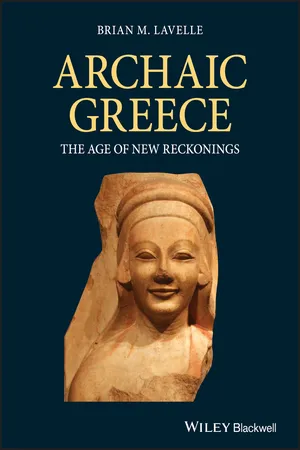
- English
- ePUB (mobile friendly)
- Available on iOS & Android
About this book
An introductory guide to the Archaic period in ancient Greece—the people, their society, and their culture. Excerpts from literary and other texts give voice to the interests, concerns, and emotions of the Archaic Greeks themselves.
This book provides a brief but comprehensive introduction to the society and culture of the Archaic period in the Greek world from c. 750 to c. 480 BCE. It focuses on the persistent and often-conflicting themes, topics, and controversies of the Archaic Age (e.g., elite and non-elite, religion and science, tradition and humanism). It seeks to lead the reader to a broader and deeper understanding of the period by placing themes and topics in a mutually supportive contextual network that will underscore their significance.
Archaic Greece: The Age of New Reckonings begins with a chapter on how sources for the period are evaluated and deployed, and goes on to offer a concise yet thorough historical overview of the Archaic period. Subsequent chapters cover polis and politics; war and violence; religion; science; philosophy; art; literature; festivals and games; social forces, values, and behaviors; and gender and sex.
The book:
- Offers a novel approach to a very significant period that foregrounds literary evidence and the words voiced by Archaic Greeks, combining scholarship with readability;
- Conceptualizes Archaic Greek culture and society by focusing substantially on topics that supplement the history of the period;
- Combines diverse elements of society and culture, including religion, art, literature, games and festivals, gender, sexuality, and politics in order to develop a unique picture of Greece during the Archaic period;
- Includes a summarizing essay that draws chapters together, emphasizing the implications of their topics and themes.
Archaic Greece: The Age of New Reckonings should appeal to college-level instructors as a book to assign to students enrolled in courses involving Archaic Greece and to others interested in this intriguing and pivotal period in ancient Greece.
Frequently asked questions
- Essential is ideal for learners and professionals who enjoy exploring a wide range of subjects. Access the Essential Library with 800,000+ trusted titles and best-sellers across business, personal growth, and the humanities. Includes unlimited reading time and Standard Read Aloud voice.
- Complete: Perfect for advanced learners and researchers needing full, unrestricted access. Unlock 1.4M+ books across hundreds of subjects, including academic and specialized titles. The Complete Plan also includes advanced features like Premium Read Aloud and Research Assistant.
Please note we cannot support devices running on iOS 13 and Android 7 or earlier. Learn more about using the app.
Information
1
Sources for the Archaic Period
1.1 Introduction
1.2 Archaeology and the Material Remains
1.2.1 Pottery


Box 1.1 The “Cup of Nestor”
Table of contents
- Cover
- Table of Contents
- Figures and Source‐Acknowledgments
- Preface
- Acknowledgments
- Abbreviations and Citations
- Maps
- 1 Sources for the Archaic Period
- 2 A Brief Overview of the Archaic Period
- 3 Polis and Politics in Archaic Greece
- 4 War and Violence in Archaic Greece
- 5 Archaic Greek Myth and Religion
- 6 Early Greek Science
- 7 Archaic Greek Philosophy
- 8 The Art of the Archaic Greeks
- 9 Archaic Greek Literature
- 10 Festivals and Games of the Archaic Greeks
- 11 Cultural Identity, Social Forces, Values, and Behaviors
- 12 Gender and Sexuality in Archaic Greece
- 13 Epilogue
- Glossary of Greek Terms
- Index: Literary Citations
- Index
- End User License Agreement